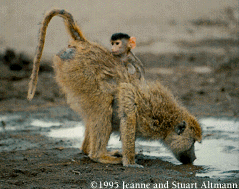 The University of Chicago Magazine August 1995
The University of Chicago Magazine August 1995


That plan soon changed. "I got interested in the methodology," she says, "and increasingly got interested in the behavior itself."
With Michael--and later his sister, Rachel--accompanying the researchers in their Land Rover-cum-nursery, Jeanne Altmann joined her husband in the field. With a statistician's sense for the value of reliable data, she devised new methodologies that removed the tendency to record only eye-catching behaviors like aggression and mating--a mistake that stemmed, she says, from a "false dichotomy" made between the lab work of scientists and the field studies of naturalists. Her techniques, such as noting all instances of a single behavior, or noting everything that a single animal does, have changed fieldwork throughout behavioral studies.
On their third trip to Kenya in 1971, a year after Stuart came to Chicago, the Altmanns began a longitudinal study of the baboons' behavior and demographics, observing the animals from just a few feet away. With the help of graduate students and the project's Kenyan staff, the study continues uninterrupted to this day. The Altmanns--Jeanne completed her Ph.D. once the children were in school, and was named a full professor in 1989--have made dozens of trips to Amboseli, sometimes for more than a year at a stretch.
While baboons, if they survive infancy, live an average of 15 years, Jeanne Altmann says "there are fewer than a dozen really long-term studies for any primate around the world." Because of political instabilities and conservation problems where primates live, she adds, "That's not likely to get any better."
Yet Stuart Altmann's most recent work illustrates the insights that only a longitudinal project can provide. In 1974 he began an exhaustive dietary study of young baboons going through the nearly year-long process of weaning. "I used to think that feeding and foraging was the dullest kind of behavior to study," he admits. "You see an animal munch and crunch on a leaf, and you see it again, and by the time you've seen the tenth leaf, you figure, `What else is there to say?'"
A lot, he found. Labeled as omnivores, baboons show a "mind-boggling" selectivity in what they eat. Though the array of what's ripe, flowering, or sprouting changes almost every two weeks in Amboseli, the animals "feed on the most nutritious part of the most nutritious plants that are available at each time of the year." Yet, he notes, "We have no evidence of social teaching. For example, I've never seen a mother hand her infant a piece of food of a type it's never tasted before."
A bigger surprise came by tracking the baboons into adulthood--to investigate what he calls the question that "I was really interested in, but didn't think would pan out." Is there a link, he wondered, between the quality of a weanling's diet--the protein and calories it consumes--and its lifetime biological fitness? Different from physical fitness, this property, measured by factors like life span and number of offspring, describes an animal's ability to pass on its genes to the next generation.
At best, Altmann hoped for a weak correlation. But, he says, "To my utter astonishment, the diet of these baboons as weanlings is a very good predictor of what happens to them for the rest of their lives in terms of [biological] fitness." So good, in fact, that he didn't believe his calculations at first, and promptly repeated them on a different computer with different software. Finally convinced, he reported his finding in 1991 in the Proceedings of the National Academy of Sciences; he's also submitted a book on the feeding study to the U of C Press.
Of the diet study's most surprising conclusion, he cautions, "Correlation and causation are not the same." A third factor, such as an animal's physical constitution, may cause both good diet and biological success. His best guess: "All these things are so intertwined that you can't separate them."
CONTINUE READING "THE BABOONS OF KENYA"